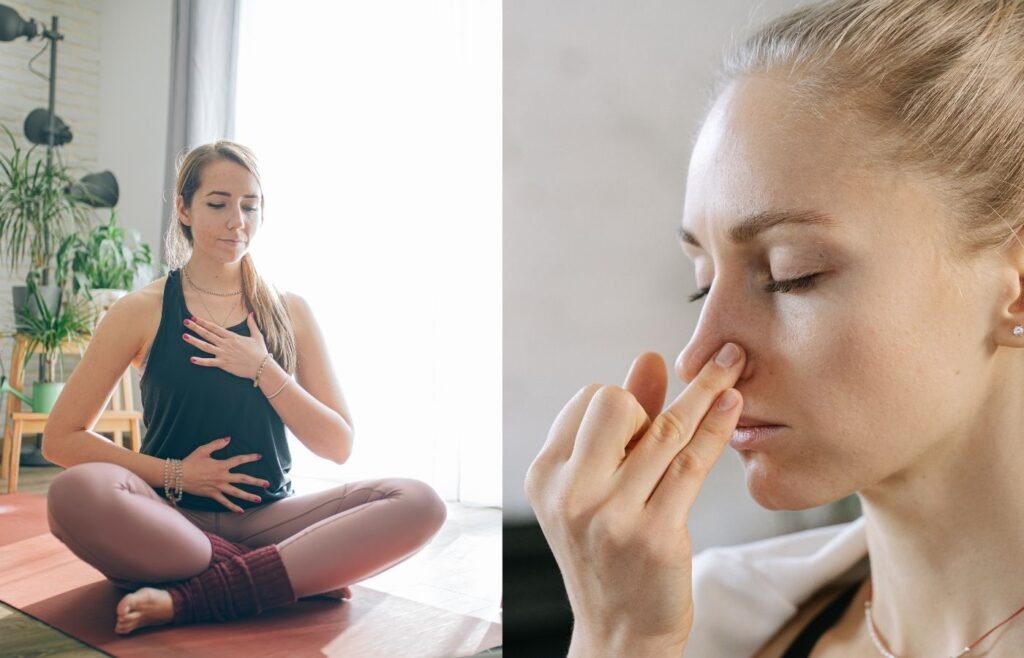
How to Use Conscious Breathing to Reduce Stress in 5 Easy Steps
Picture this: you’re feeling overwhelmed, your mind racing with a million thoughts, and stress seems to have made itself a permanent resident in your life. What if there was a simple, ancient practice that could help you find calm in the chaos? Enter conscious breathing.
Across various cultures, conscious breathing has stood the test of time as a powerful tool for stress reduction. In today’s fast-paced world, where stress is seemingly unavoidable, this age-old technique holds more relevance than ever.
In this article, we’ll delve into the science-backed benefits of conscious breathing for stress management.
Not only will you gain valuable insights into how conscious breathing can transform your relationship with stress, but you’ll also discover 5 easy-to-follow steps that you can start using right away to bring a sense of peace and serenity into your daily life.
So, if you’re ready to embark on a journey towards a calmer, more centered self, read on to unlock the incredible potential of mindful breathing in managing stress.
Table of Contents
ToggleAffiliate disclosure: some of the links on this site are affiliate links, meaning at no additional cost to you, I will be earning a commission if you click through and purchase.

The Science of Conscious Breathing for Stress Reduction
Activating the Relaxation Response
One of the key benefits of conscious breathing is its ability to activate the body’s relaxation response.
Deep breathing promotes a state of calmness and well-being by stimulating the parasympathetic nervous system, counteracting the stress response. This is achieved through:
Decreased heart rate
Lower blood pressure
Reduced muscle tension
Changes in the body during deep breathing
Deep breathing exercises have been found to bring about several physiological changes that contribute to stress reduction. These include:
Enhanced oxygenation of the blood, leading to improved circulation and delivery of oxygen to tissues
Regulation of the autonomic nervous system, shifting it towards a more balanced state and reducing the dominance of the sympathetic (fight-or-flight) response
As a result of these changes, individuals experience reduced physiological triggers and increased mental clarity.
By understanding these mechanisms, individuals can harness the power of breath control to effectively manage stress and promote overall well-being.
Benefits of Using Conscious Breathing to Manage Stress

Conscious breathing is a powerful technique that can have numerous benefits for stress relief and overall well-being. When you start integrating mindful breathing into your everyday schedule, you can experience the following benefits:
1. Promotes relaxation
Deep breathing is important for promoting relaxation as it slows down the heart rate and brings about feelings of calmness and clarity. Taking slow, deep breaths signals to the body that it is safe and triggers the rest-and-digest response through the activation of the parasympathetic nervous system.
2. Immediate stress reduction
The regular practice of breathing techniques can help in the immediate reduction of stress levels. When you focus on your breath and take slow, intentional breaths, it helps shift your attention away from stressors and allows you to enter a state of relaxation.
3. Long-term resilience
In addition to helping you feel less stressed immediately, regularly practicing breathing exercises can also help you build long-term resilience to handle future stress. Embracing mindful breathing daily will train your body to respond more effectively to stress and cultivate a sense of inner calm even when faced with challenging situations.
4. Improved sleep quality
A lack of sleep can contribute to stress by disrupting hormonal balance, impairing cognitive functioning and emotional regulation, and compromising overall well-being. But incorporating conscious breathing into your bedtime routine you can help improve sleep quality. Deep breathing before bed helps activate the relaxation response in your body, preparing you for a restful night’s sleep.
5. Enhanced focus
Breathing techniques can improve focus and concentration by bringing your attention to the present moment. When you focus on your breath, it anchors your attention and helps reduce distractions and external stressors, allowing you to be more present and focused on the task at hand.
6. Greater self-awareness
Regular practice of deep breathing exercises can enhance self-awareness by connecting you with your body and emotions. As you pay attention to your breath, you become more attuned to physical sensations, thoughts, and emotions that arise within you, leading to a greater sense of self-awareness. This increased self-awareness can also help you recognize signs of stress in your body and emotions. By being more connected to yourself through mindful breathing, you can better identify when stress is present and take proactive steps to manage and reduce it.
By adding breath awareness to your daily routine, you can enjoy these amazing benefits and create a stronger sense of calm, strength, and overall well-being in your life.
Four Easy Breathing Exercises to Get You Started
Breathing exercises are a powerful tool for reducing stress and promoting a sense of calm.
Here are four simple yet effective techniques to incorporate into your daily routine:
1. Box Breathing
This technique, also known as square breathing, involves inhaling, holding the breath, exhaling, and holding the breath again – each for an equal count of seconds. For example, you can start by inhaling for a count of four seconds, holding for four seconds, exhaling for four seconds, and holding again for four seconds. The structured nature of box breathing helps to calm the mind and reduce stress levels by promoting deep relaxation.
2. 4-7-8 Breathing
With this technique, you inhale quietly through your nose for a count of 4 seconds, hold your breath for 7 seconds, and then exhale forcefully through your mouth for 8 seconds. This practice is designed to quiet the mind and stimulate the body’s natural relaxation response. It can be especially helpful when trying to fall asleep or during moments of heightened stress.

3. Diaphragmatic Breathing
Also known as belly breathing, this technique involves breathing deeply into your diaphragm rather than taking shallow breaths into your chest. To practice diaphragmatic breathing:
Place one hand on your chest and the other on your abdomen.
As you breathe in deeply through your nose, focus on allowing your abdomen to rise while keeping your chest relatively still.
This promotes relaxation and reduces tension in the body.
4. Alternate Nostril Breathing
This ancient yogic breathing technique aims to balance the flow of energy in the body and calm the mind. To practice alternate nostril breathing:
Sit comfortably with your spine straight.
Use your right thumb to close your right nostril and inhale deeply through your left nostril.
Then use your right ring finger to close your left nostril as you release your right nostril and exhale through it.
Continue this pattern, alternating nostrils with each breath.

Incorporating these simple yet potent breathing exercises into your daily routine can have a profound impact on your overall sense of well-being and ability to manage stress effectively.
Remember that consistency is key when it comes to reaping the benefits of conscious breathing. By making these exercises a regular part of your day, you can experience a noticeable difference in your stress levels and overall mindset.
Five Easy Steps to Use Mindful Breathing for Stress Reduction
When it comes to using mindful breathing for stress reduction, there are five easy steps you can follow to get started.
By incorporating these steps into your daily routine, you can harness the power of breathing exercises to calm your mind and reduce stress levels. Let’s dive in:
Step 1: Finding a Comfortable Place
Find a quiet and comfortable space where you can practice without distractions. This could be your bedroom, living room, or even a peaceful outdoor spot. Creating a serene environment will help you relax and focus on your breathing.
Step 2: Avoiding Forceful Breathing
One common mistake people make is forceful or exaggerated breathing. Instead, aim for gentle and natural breaths. Allow the breath to flow in and out effortlessly, without straining or forcing it. This will help promote a sense of ease and relaxation.
Step 3: Wearing Comfortable Clothes
It’s important to wear loose and comfortable clothing during your practice. Tight or restrictive clothing can hinder your ability to take deep, full breaths into your belly. Opt for breathable fabrics that allow for freedom of movement.
Step 4: Focusing on Deep Breaths into the Belly
Deep breathing is a key component for stress reduction. As you inhale, imagine drawing the breath deep into your belly rather than shallow chest breathing. This allows for maximum oxygenation of the blood and activates the body’s relaxation response.
Step 5: Using Breath Focus Techniques to Imagine Peace and Calm
To enhance the effectiveness of your practice, incorporate breath focus techniques that help you imagine peace and calm. For example, as you inhale deeply, visualize yourself inhaling calm and exhaling any tension or stress. You can also repeat a calming mantra or affirmation in your mind with each breath.
By following these five easy steps, you can effectively use conscious breathing for stress reduction.
Remember, that consistency is crucial. Aim to incorporate these steps into your daily routine and make it a habit.
With regular practice, you’ll begin to experience the profound benefits of this ancient practice in managing and alleviating stress.

Making Mindful Breathing a Daily Habit for Long-lasting Stress Management
Conscious breathing is a powerful tool for managing stress and promoting overall well-being.
While it’s easy to think of it as something we only do during designated meditation or yoga sessions, the truth is that incorporating intentional breathing into our daily lives can have a significant impact on our stress levels.
Here are some practical ways to make it a daily habit:
Set Reminders: In the hustle and bustle of our busy lives, it’s all too easy to forget about taking a moment to breathe. Setting reminders on your phone can be a helpful way to prompt yourself throughout the day.
Link it to Existing Habits: Another effective strategy is to link mindful breathing to activities you already do regularly. For example, you could take three deep breaths every time you make a cup of tea or coffee, before starting a new task, or during your lunch break. When you start associating it with existing habits, you’re more likely to remember and incorporate it into your routine.
Include it in Your Morning or Bedtime Ritual: Start your day off on the right foot by incorporating mindful breathing into your morning routine, or end your day by using breathing techniques to wind down at night.
Don’t forget, consistency is key when it comes to establishing any new habit, including breath work. It’s better to start small and be consistent rather than trying to do too much at once and getting overwhelmed.
Even just a few minutes of intentional breathing each day can make a big difference in how you feel.
“Take a moment. Breathe deeply. Be present.”
So why not give it a try? Start by finding a comfortable position, closing your eyes if you’d like, and taking a deep breath in through your nose and out through your mouth.
And remember, there’s no right or wrong way to breathe. The most important thing is that you’re taking the time for yourself and giving your body and mind a chance to reset and recharge.
Enhancing Your Breathing Practice
When it comes to incorporating conscious breathing into your daily routine, there are several ways to enhance your experience and deepen your practice. Here are some tips and guidance to support you on your journey:
1. Explore Guided Meditation Resources
If you’re new to conscious breathing or prefer having external support, consider exploring guided meditation resources. There are a variety of mobile apps and online audio recordings available that provide structure and deeper guidance for your practice. These resources can help you stay focused, offer different techniques to try, and create a more immersive experience.
2. Find a Teacher or Community
Connecting with a knowledgeable teacher or joining a breath work community can be incredibly beneficial. They can provide valuable insights, answer questions, and offer personalized guidance based on your specific needs and goals. Being part of a community can also foster a sense of support and accountability, making it easier to stay motivated and committed to your practice.
3. Experiment with Different Techniques
Mindful breathing is a vast field with various techniques to explore. Don’t be afraid to experiment and find what works best for you. Each technique has its own unique benefits and effects on the body and mind. By trying different approaches, you can discover which ones resonate with you the most.
Remember, enhancing your breathing experience is about finding what supports you on your journey towards stress reduction and inner calm.
Whether it’s through guided resources, seeking guidance from a teacher or community, or exploring different techniques, these tools can help you deepen your practice and reap even greater benefits from conscious breathing.
So why not give it a try? Explore the various resources available, connect with others who share your interest in breath work, and continue on this path toward cultivating peace and calm in your life.

The Bottom Line
Conscious breathing is an amazing practice that embraces simplicity while offering profound effectiveness. It serves as a powerful tool to reduce stress and foster overall well-being. Once you dive into the techniques and tips shared in this article, you too can experience the profound benefits firsthand and start living a life filled with peace and calm.
Mindful breathing has been used for centuries in various cultures as a technique to manage and alleviate stress. In today’s fast-paced world where stress seems to lurk around every corner, it is more important than ever to prioritize our mental and physical health.
Have any questions?
If you have tried any methods that you recommend, or if you have any questions, leave a comment below!





2 Comments
Lana
23/03/2024 at 6:51 PM
This is beautiful. I love that you advocate for serene living. Thank you for being you Melanie. 🙂
Michele
25/03/2024 at 4:41 PM
I’m so glad you like it Lana – I believe we all could use some calm and serenity in our modern, busy lives. It’s so easy to get caught up in everything we want to accomplish that we forget the here and now. 🙂